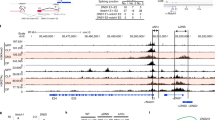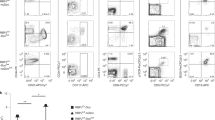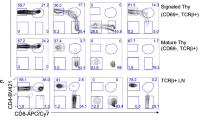Abstract
Signaling through the transmembrane Notch1 receptor directs thymus-seeding progenitors (TSPs) to suppress their B cell potential and 'choose' the T cell fate. Present paradigms suggest that TSPs are contained in the multipotent early T lineage precursor (ETP) subset of thymocytes. However, we show here that the B cell potential of ETPs was not augmented in microenvironments that limited Notch1 activation. Furthermore, low-threshold Notch1 signals suppressed B cell production by TSPs before they reached the ETP stage. Notch1 signals of a higher threshold were needed to drive proliferation of ETPs and development into CD4+CD8+ double-positive thymocytes. Thus, TSPs can be differentiated from all previously identified early T cell progenitors by their robust B cell potential and exquisite sensitivity to Notch1 signals.
This is a preview of subscription content, access via your institution
Access options
Subscribe to this journal
Receive 12 print issues and online access
$209.00 per year
only $17.42 per issue
Buy this article
- Purchase on Springer Link
- Instant access to full article PDF
Prices may be subject to local taxes which are calculated during checkout








Similar content being viewed by others
References
Maillard, I., Adler, S.H. & Pear, W.S. Notch and the immune system. Immunity 19, 781–791 (2003).
Radtke, F., Wilson, A., Mancini, S.J. & MacDonald, H.R. Notch regulation of lymphocyte development and function. Nat. Immunol. 5, 247–253 (2004).
Radtke, F. et al. Notch1 deficiency dissociates the intrathymic development of dendritic cells and T cells. J. Exp. Med. 191, 1085–1094 (2000).
Wilson, A., MacDonald, H.R. & Radtke, F. Notch 1-deficient common lymphoid precursors adopt a B cell fate in the thymus. J. Exp. Med. 194, 1003–1012 (2001).
Han, H. et al. Inducible gene knockout of transcription factor recombination signal binding protein-J reveals its essential role in T versus B lineage decision. Int. Immunol. 14, 637–645 (2002).
Izon, D.J. et al. Deltex1 redirects lymphoid progenitors to the B cell lineage by antagonizing Notch1. Immunity 16, 231–243 (2002).
Maillard, I. et al. Mastermind critically regulates Notch-mediated lymphoid cell fate decisions. Blood 104, 1696–1702 (2004).
Koch, U. et al. Subversion of the T/B lineage decision in the thymus by Lunatic Fringe-mediated inhibition of Notch1. Immunity 15, 225–236 (2001).
Haines, N. & Irvine, K.D. Glycosylation regulates Notch signalling. Nat. Rev. Mol. Cell Biol. 4, 786–797 (2003).
Koch, U., Yuan, J.S., Harper, J.A. & Guidos, C.J. Fine-tuning Notch1 activation by endocytosis and glycosylation. Semin. Immunol. 15, 99–106 (2003).
Pui, J.C. et al. Notch1 expression in early lymphopoiesis influences B versus T lineage determination. Immunity 11, 299–308 (1999).
Jaleco, A.C. et al. Differential effects of Notch ligands Delta-1 and Jagged-1 in human lymphoid differentiation. J. Exp. Med. 194, 991–1002 (2001).
Schmitt, T.M. & Zuniga-Pflucker, J.C. Induction of T cell development from hematopoietic progenitor cells by Delta-like-1 in vitro. Immunity 17, 749–756 (2002).
Hozumi, K. et al. Delta-like 1 is necessary for the generation of marginal zone B cells but not T cells in vivo. Nat. Immunol. 5, 638–644 (2004).
Foss, D.L., Donskoy, E. & Goldschneider, I. The importation of hematogenous precursors by the thymus is a gated phenomenon in normal adult mice. J. Exp. Med. 193, 365–374 (2001).
Donskoy, E., Foss, D. & Goldschneider, I. Gated importation of prothymocytes by adult mouse thymus is coordinated with their periodic mobilization from bone marrow. J. Immunol. 171, 3568–3575 (2003).
Ceredig, R. & Rolink, T. A positive look at double-negative thymocytes. Nat. Rev. Immunol. 2, 888–897 (2002).
Bhandoola, A., Sambandam, A., Allman, D., Meraz, A. & Schwarz, B. Early T lineage progenitors: new insights, but old questions remain. J. Immunol. 171, 5653–5658 (2003).
Wu, L., Antica, M., Johnson, G.R., Scollay, R. & Shortman, K. Developmental potential of the earliest precursor cells from the adult mouse thymus. J. Exp. Med. 174, 1617–1627 (1991).
Matsuzaki, Y. et al. Characterization of c-kit positive intrathymic stem cells that are restricted to lymphoid differentiation. J. Exp. Med. 178, 1283–1292 (1993).
Ardavin, C., Wu, L., Li, C.L. & Shortman, K. Thymic dendritic cells and T cells develop simultaneously in the thymus from a common precursor population. Nature 362, 761–763 (1993).
Moore, T.A. & Zlotnik, A. T-cell lineage commitment and cytokine responses of thymic progenitors. Blood 86, 1850–1860 (1995).
Allman, D. et al. Thymopoiesis independent of common lymphoid progenitors. Nat. Immunol. 4, 168–174 (2003).
Kondo, M., Weissman, I.L. & Akashi, K. Identification of clonogenic common lymphoid progenitors in mouse bone marrow. Cell 91, 661–672 (1997).
Izon, D. et al. A common pathway for dendritic cell and early B cell development. J. Immunol. 167, 1387–1392 (2001).
Adolfsson, J. et al. Upregulation of Flt3 expression within the bone marrow Lin−Sca1+c-kit+ stem cell compartment is accompanied by loss of self-renewal capacity. Immunity 15, 659–669 (2001).
Sitnicka, E. et al. Key role of flt3 ligand in regulation of the common lymphoid progenitor but not in maintenance of the hematopoietic stem cell pool. Immunity 17, 463–472 (2002).
Schwarz, B.A. & Bhandoola, A. Circulating hematopoietic progenitors with T lineage potential. Nat. Immunol. 5, 953–960 (2004).
Martin, C.H. et al. Efficient thymic immigration of B220+ lymphoid-restricted bone marrow cells with T precursor potential. Nat. Immunol. 4, 866–873 (2003).
Porritt, H.E. et al. Heterogeneity among DN1 prothymocytes reveals multiple progenitors with different capacities to generate T cell and non-T cell lineages. Immunity 20, 735–745 (2004).
Tanigaki, K. et al. Regulation of αβ/γδ T cell lineage commitment and peripheral T cell responses by Notch/RBP-J signaling. Immunity 20, 611–622 (2004).
Wolfer, A., Wilson, A., Nemir, M., MacDonald, H.R. & Radtke, F. Inactivation of Notch1 impairs VDJβ rearrangement and allows pre-TCR-independent survival of early αβ lineage thymocytes. Immunity 16, 869–879 (2002).
Ciofani, M. et al. Obligatory role for cooperative signaling by pre-TCR and Notch during thymocyte differentiation. J. Immunol. 172, 5230–5239 (2004).
Schmitt, T.M., Ciofani, M., Petrie, H.T. & Zuniga-Pflucker, J.C. Maintenance of T cell specification and differentiation requires recurrent notch receptor-ligand interactions. J. Exp. Med. 200, 469–479 (2004).
Huang, E.Y., Gallegos, A.M., Richards, S.M., Lehar, S.M. & Bevan, M.J. Surface expression of Notch1 on thymocytes: correlation with the double-negative to double-positive transition. J. Immunol. 171, 2296–2304 (2003).
Heitzler, P. & Simpson, P. The choice of cell fate in the epidermis of Drosophila. Cell 64, 1083–1092 (1991).
Greenwald, I. LIN-12/Notch signaling: lessons from worms and flies. Genes Dev. 12, 1751–1762 (1998).
Balciunaite, G., Ceredig, R. & Rolink, A.G. The earliest subpopulation of mouse thymocytes contains potent T, significant macrophage and natural killer, but no B lymphocyte potential. Blood (2004).
Nakano, T., Kodama, H. & Honjo, T. Generation of lymphohematopoietic cells from embryonic stem cells in culture. Science 265, 1098–1101 (1994).
Mazurier, F., Doedens, M., Gan, O.I. & Dick, J.E. Rapid myeloerythroid repopulation after intrafemoral transplantation of NOD-SCID mice reveals a new class of human stem cells. Nat. Med. 9, 959–963 (2003).
Hope, K.J., Jin, L. & Dick, J.E. Acute myeloid leukemia originates from a hierarchy of leukemic stem cell classes that differ in self-renewal capacity. Nat. Immunol. 5, 738–743 (2004).
Hardy, R.R. et al. B-cell commitment, development and selection. Immunol. Rev. 175, 23–32 (2000).
Washburn, T. et al. Notch activity influences the αβ versus γδ T cell lineage decision. Cell 88, 833–843 (1997).
Radtke, F. et al. Deficient T cell fate specification in mice with an induced inactivation of Notch1. Immunity 10, 547–558 (1999).
Mori, S., Shortman, K. & Wu, L. Characterization of thymus-seeding precursor cells from mouse bone marrow. Blood 98, 696–704 (2001).
Ikawa, T. et al. Identification of the earliest prethymic T-cell progenitors in murine fetal blood. Blood 103, 530–537 (2004).
Masuda, K. et al. Thymic anlage is colonized by progenitors restricted to T, NK, and dendritic cell lineages. J. Immunol. 174, 2525–2532 (2005).
Harman, B.C. et al. T/B lineage choice occurs prior to intrathymic notch signalling. Blood (2005).
Kincade, P.W. et al. Nature or nurture? Steady-state lymphocyte formation in adults does not recapitulate ontogeny. Immunol. Rev. 187, 116–125 (2002).
Tomita, K. et al. The bHLH gene Hes1 is essential for expansion of early T cell precursors. Genes Dev. 13, 1203–1210 (1999).
Kawamata, S., Du, C., Li, K. & Lavau, C. Overexpression of the Notch target genes Hes in vivo induces lymphoid and myeloid alterations. Oncogene 21, 3855–3863 (2002).
Taghon, T.N., David, E.S., Zuniga-Pflucker, J.C. & Rothenberg, E.V. Delayed, asynchronous, and reversible T-lineage specification induced by Notch/Delta signaling. Genes Dev. 19, 965–978 (2005).
Yun, T.J. & Bevan, M.J. Notch-regulated ankyrin-repeat protein inhibits Notch1 signaling: multiple Notch1 signaling pathways involved in T cell development. J. Immunol. 170, 5834–5841 (2003).
Cheng, Y.C. et al. Notch activation regulates the segregation and differentiation of rhombomere boundary cells in the zebrafish hindbrain. Dev. Cell 6, 539–550 (2004).
Wu, L., Li, C.L. & Shortman, K. Thymic dendritic cell precursors: relationship to the T lymphocyte lineage and phenotype of the dendritic cell progeny. J. Exp. Med. 184, 903–911 (1996).
Lee, C.K. et al. Generation of macrophages from early T progenitors in vitro. J. Immunol. 166, 5964–5969 (2001).
Acknowledgements
We thank C. Paige (Ontario Cancer Institute, Toronto, Canada) for OP9 cells; J. Dick and M. Doedens (University Health Network, Toronto, Canada) as well as L. Nutter for help with intrafemoral injections; S. Zhao for cell sorting; H. Petrie (University of Miami, Miami, Florida), W. Pear and A. Bhandoola (University of Pennsylvania, Philadelphia, Pennsylvania) for sharing data before publication; H. Petrie for Ter119; and J. Danska and M. Anderson (Sunnybrook & Women's College Hospital, Toronto, Canada) for comments on the manuscript. Supported by the Canadian Institutes of Health Research (C.J.G.) and Hospital for Sick Children (Restracom Studentship to J.Y.).
Author information
Authors and Affiliations
Corresponding author
Ethics declarations
Competing interests
The authors declare no competing financial interests.
Supplementary information
Supplementary Fig. 1
Inefficient Production of DP Thymocytes from Notch1+/− HSCs in Mixed BM Chimeras. (PDF 82 kb)
Supplementary Fig. 2
Normal Steady State Production of Thymic T and B Cells in Notch1+/− Mice. (PDF 95 kb)
Supplementary Fig. 3
Analysis of Donor Contribution to HSCs and DN Thymocyte Subsets in Mixed Chimeras. (PDF 101 kb)
Supplementary Fig. 4
Effect of Transgenic L-Fng on Committed B Cell Progenitors. (PDF 70 kb)
Supplementary Table 1
ETPs Efficiently Reconstitute All Thymic Subsets in WT and Tg+ Hosts. (PDF 52 kb)
Rights and permissions
About this article
Cite this article
Tan, J., Visan, I., Yuan, J. et al. Requirement for Notch1 signals at sequential early stages of intrathymic T cell development. Nat Immunol 6, 671–679 (2005). https://doi.org/10.1038/ni1217
Received:
Accepted:
Published:
Issue Date:
DOI: https://doi.org/10.1038/ni1217
This article is cited by
-
A double-negative thymocyte-specific enhancer augments Notch1 signaling to direct early T cell progenitor expansion, lineage restriction and β-selection
Nature Immunology (2022)
-
Fibrotic liver microenvironment promotes Dll4 and SDF-1-dependent T-cell lineage development
Cell Death & Disease (2019)
-
Trap1a is an X-linked and cell-intrinsic regulator of thymocyte development
Cellular & Molecular Immunology (2017)
-
Induction of Bcl11b during T cell commitment through a tripartite mechanism
Nature Immunology (2016)
-
Developmental gene networks: a triathlon on the course to T cell identity
Nature Reviews Immunology (2014)



